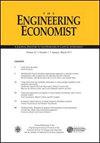癌症放射治疗计划中患者特定运动管理策略的成本效益
IF 1.2
4区 经济学
Q4 BUSINESS
引用次数: 0
摘要
摘要医学中的成本效益分析是一种比较医疗技术和医疗服务相对价值的经济学研究形式。它有助于决策者正式评估拟议的干预措施,并根据每项干预措施每花费一美元的估计健康收益做出明智的选择。本研究采用CEA框架来评估一种新兴的成像技术,以确定其在常规患者护理中的应用是否合适。在肺癌癌症放射治疗(RT)中的一个重大挑战是正电子发射断层扫描/计算机断层扫描(PET/CT)期间呼吸诱导的肿瘤运动。呼吸门控可以改善图像质量和向肿瘤输送治疗剂量。呼吸门控PET/CT对局部晚期和无法手术的非小细胞肺癌癌症(NSCLC)特别有用。由于患者呼吸模式的异质性,关于谁将从呼吸门控中受益的问题仍然存在。呼吸门控的有效性可以通过使用PET/CT图像中的定量改进来测量。我们之前开发了一种患者特异性运动管理(PSMM)范式,以基于呼吸模式分析来识别受益于呼吸门控PET/CT的患者。本文提出了一个新的CEA框架,以评估PSMM与1500多名癌症患者基于人群的放射肿瘤学运动管理实践相比的成本效益。本文章由计算机程序翻译,如有差异,请以英文原文为准。
Cost-effectiveness of patient-specific motion management strategy in lung cancer radiation therapy planning
Abstract Cost-effectiveness analysis (CEA) in medicine is a form of economic study that compares the relative value of medical technologies and health care services. It helps decision makers to formally evaluate proposed interventions and make informed choices based on the estimated health gains per dollar spent under each intervention. This study employs a CEA framework to assess an emerging imaging technology to determine whether its adoption will be appropriate in routine patient care. A significant challenge in lung cancer radiotherapy (RT) is respiration-induced tumor motion during positron emission tomography/computed tomography (PET/CT). Respiratory gating may improve the image quality and delivery of curative doses to tumor. Respiratory-gated PET/CT is especially useful for locally advanced and inoperable non–small cell lung cancer (NSCLC). Due to the heterogeneity in patients’ respiratory patterns, questions remain regarding who will benefit from respiratory gating. The effectiveness of respiratory gating can be measured by using quantitative improvements in PET/CT images. We previously developed a patient-specific motion management (PSMM) paradigm to identify patients who benefited from respiratory-gated PET/CT based on respiratory pattern analysis. This article presents a new CEA framework to evaluate the cost-effectiveness of PSMM compared to the population-based radiation oncology practice of motion management in more than 1,500 cancer patients.
求助全文
通过发布文献求助,成功后即可免费获取论文全文。
去求助
来源期刊

Engineering Economist
ENGINEERING, INDUSTRIAL-OPERATIONS RESEARCH & MANAGEMENT SCIENCE
CiteScore
2.00
自引率
0.00%
发文量
14
审稿时长
>12 weeks
期刊介绍:
The Engineering Economist is a refereed journal published jointly by the Engineering Economy Division of the American Society of Engineering Education (ASEE) and the Institute of Industrial and Systems Engineers (IISE). The journal publishes articles, case studies, surveys, and book and software reviews that represent original research, current practice, and teaching involving problems of capital investment.
The journal seeks submissions in a number of areas, including, but not limited to: capital investment analysis, financial risk management, cost estimation and accounting, cost of capital, design economics, economic decision analysis, engineering economy education, research and development, and the analysis of public policy when it is relevant to the economic investment decisions made by engineers and technology managers.
 求助内容:
求助内容: 应助结果提醒方式:
应助结果提醒方式:


